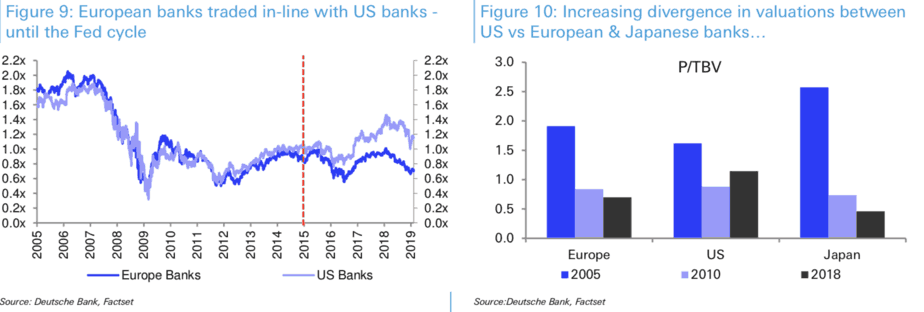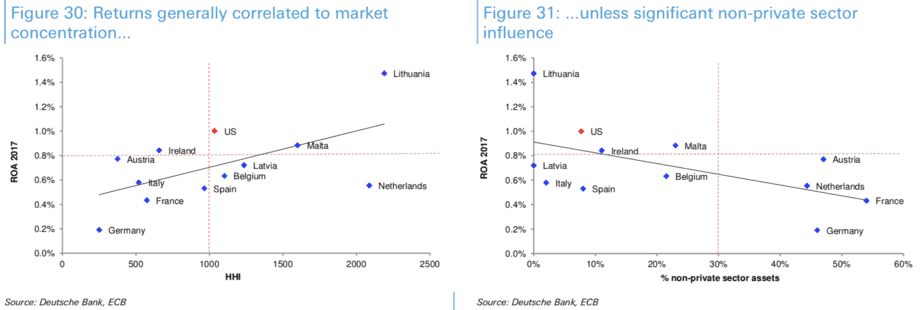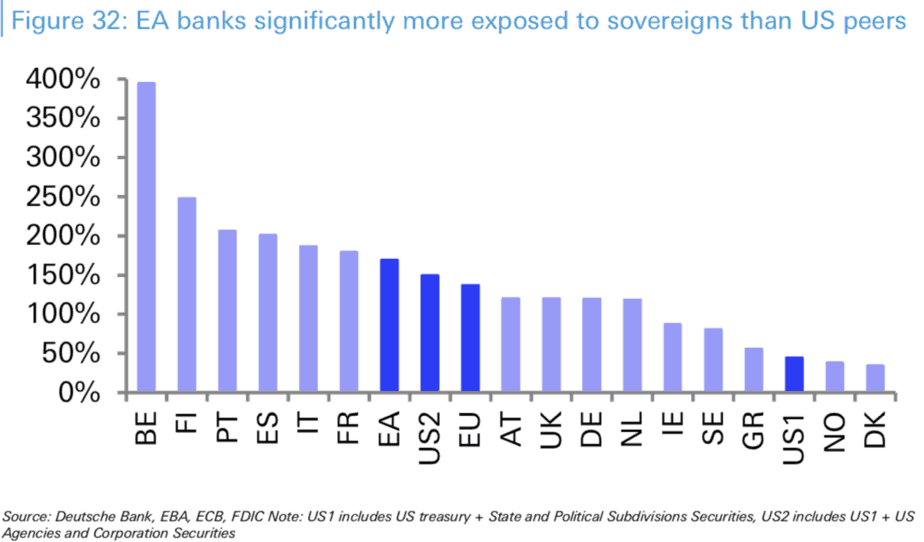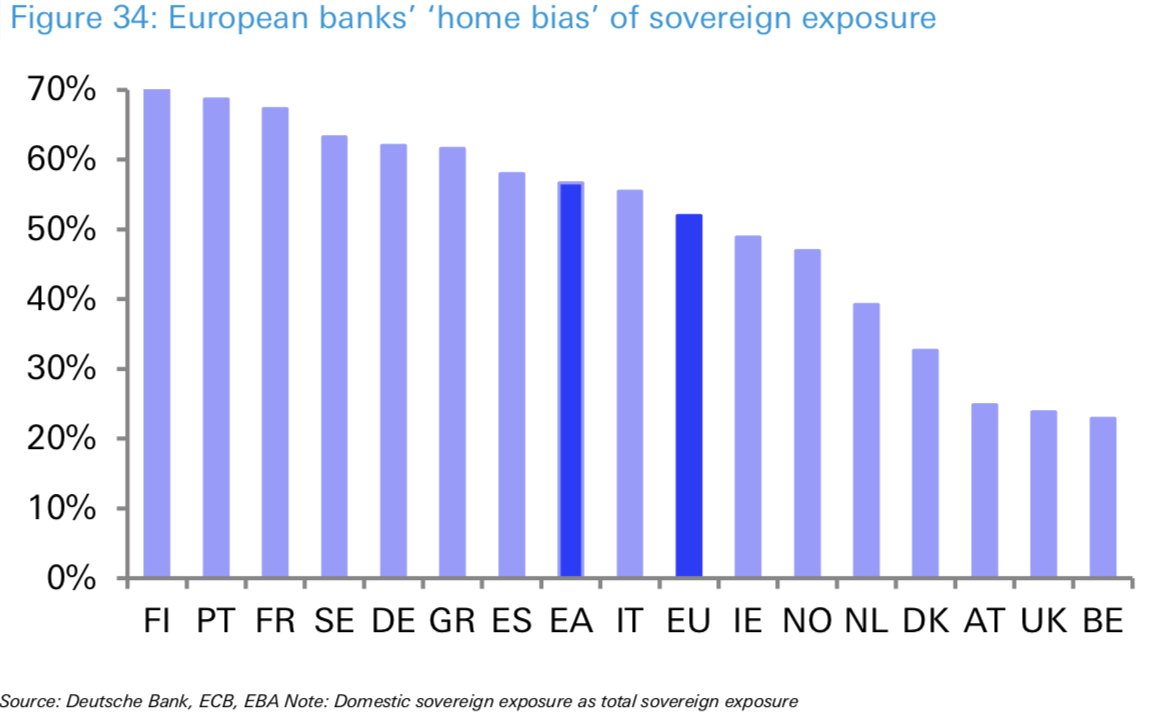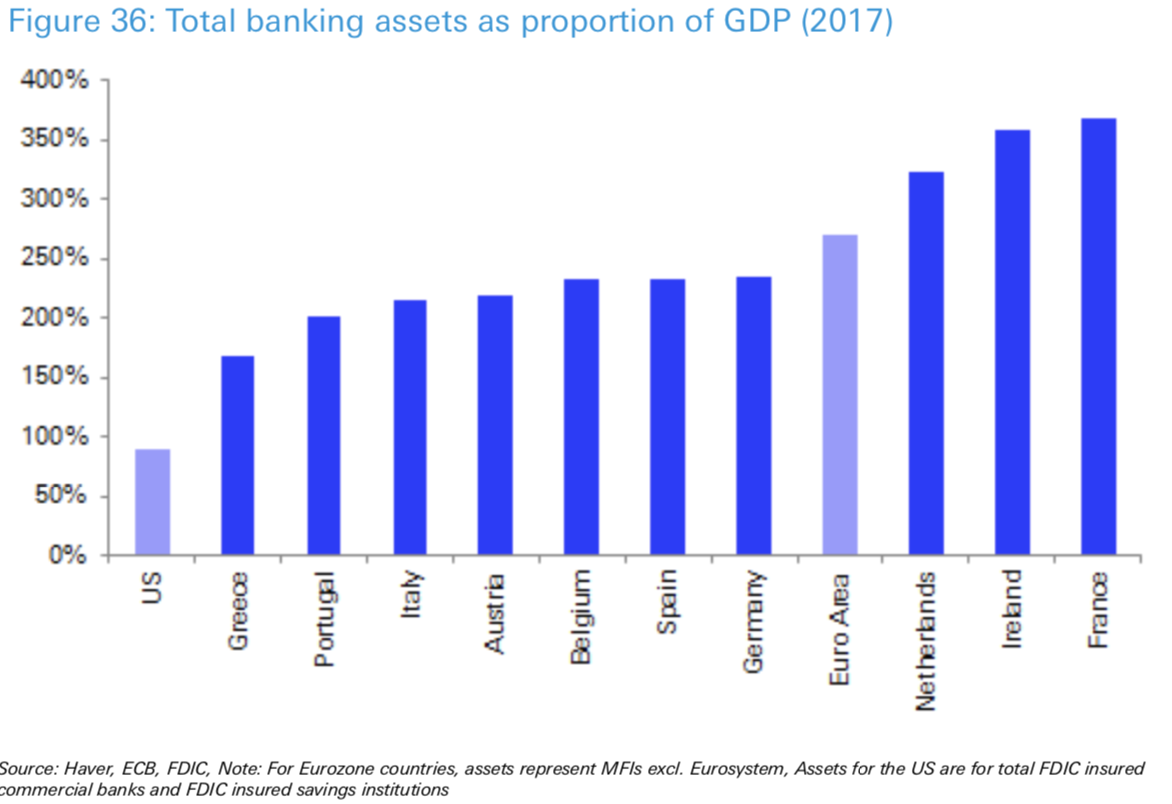Gedanken zur Sanierung des europäischen Bankensystems
Das europäische Bankensystem ist in keinem guten Zustand, allen Beteuerungen vom Gegenteil zum Trotz. Wie schlimm es aussieht, erkennt man alleine schon an den Aktienkursen. Weit von den Höchstständen entfernt, deutlich schlechter als die Wettbewerber in den USA. Gerade auch bei uns in Deutschland haben wir es mit einem Bankensystem zu tun, welches systematisch zu wenig verdient. Daran wird auch eine Fusion von Deutscher Bank und Commerzbank nichts ändern.
Dabei wäre ein gesundes Bankensystem ein wichtiger Baustein zur Überwindung der Krise in der Eurozone – ja, ich weiß, dazu gehört noch viel mehr! – und der Vermeidung eines japanischen Szenarios. Deshalb haben Analysten der Deutschen Bank einmal aufgeschrieben, was denn zu tun wäre, um die europäischen Banken zu sanieren. Interessante Lektüre:
- “The banking systems of Europe and Japan already exhibit a startling symmetry. First, households and corporates have a similar level of over-reliance on banks. Corporations in Europe and Japan tap banks for three-quarters of their financing requirements while the regions’ households rely on them for nine-tenths of funding needs. That is double and triple the proportion seen in the US, respectively.” – bto: wobei man sagen könnte, dass die geringere Ertragskraft der Banken in Deutschland den Kunden zu Gute kommt, und zwar genau den kleineren Unternehmen, die davon profitieren – im Unterschied zu den USA, wo der Nutzen des Kapitalmarktes nur die Großen begünstigt.
- “Yet although banks in Europe and Japan are leaned upon so heavily to support the real economy, falling returns leave them less able to support the sectors of the economy that need it the most. This is a serious problem, particularly as small and medium enterprises employ two-thirds of the European workforce, whereas equivalent US firms employ only about half the American workforce.” – bto: was natürlich stimmt. Nur wenn die Banken gesund genug sind, können sie dieser Aufgabe nachkommen.
- “‘(…) low profitability weakens a bank’s ability to accumulate capital‘ while drawing the connection between a sustainable business and the safety and soundness of the system. The increasing gap in profitability between European and US banks is a function of declining customer margins and, increasingly, the ECB’s ongoing negative rate environment. This has, in effect, imposed a tax worth about €8bn on the European banking industry (…) The theoretical opportunity cost of not being able to pass negative rates to household customers, based on overnight deposits, is €16bn, or five per cent of system net interest income and about ten per cent of pre-tax profit.” – bto: auch eine dieser negativen Nebenwirkungen der EZB-Politik!
- “The unintended consequence is that itacts as a fiscal transfer mechanism and redistributes cash from core Europe to the periphery. The periphery banking system is also the primary beneficiary of the €700bn TLTRO programme which can remunerate borrowing at 40 basis points.” – bto: unbeabsichtigt? Es ist Bestandteil des großen Rettungsprogramms, wo es auf allen Ebenen darum geht, eine Transferunion zu schaffen, ohne dies offiziell zu sagen.
- “Ultra-loose monetary policy is a good example of how European policymakers are copying the Japanese. While it is true that low rates mean lower provisions and higher capital gains, these effects are temporary while the compression of net interest margins is ongoing. Indeed, persistent low rates in Japan have led to net interest margins falling from 1.5 per cent in 2000 to 0.9 per cent now. In this regard, Europe is already heading down the Japanese path. While European banking margins have flat-lined at 1.65 per cent since the financial crisis, persistent low rates could significantly impact margins over time. Of course, lower margins can be good for an economy up to a certain point. But at low levels, it damages the credit transmission mechanism.” – bto: Und da darf nicht vergessen werden, dass die Banken noch faule Kredite bewältigen und das Eigenkapital stärken müssen. Beides nicht leicht, wenn man kein Geld verdient.
- “The Japanese experience proves that it is possible to keep monetary policy ultra-loose for decades and still fail to stimulate inflation while the health of the banking system deteriorates. The window to raise policy rates to address bank profitability is narrowing and the continent’s banks are at dire risk of being permanently weakened. The failure to achieve ‘escape velocity’ in Japan, and the staunch adherence to low rates, is a key reason why Japanese banks fail to cover their cost of equity.” – bto: Das System ist halt durchgehend faul.
- “The negative deposit rate compounds the fundamental problem that European banking returns are not sustainable. Take return on assets. As a rule of thumb, a well-functioning banking system should allow banks to make one per cent on their assets. US banks are very close to this mark. In contrast, European and Japanese banks both return under half a per cent on their assets (…) If we narrow down returns to what investors recoup, return on equity, European and Japanese banks generate eight per cent and five per cent respectively, well behind their US peers at 12 per cent. It is also telling that returns on equity in Europe and Japan have fallen since the aftermath of the financial crisis while in the US they have risen.” – bto: In Europa haben wir also eine schlechte Situation verschlimmert, während in den USA die (erzwungene) Rekapitalisierung, aber vor allem die weitergehende Konzentration helfen. Damit will ich keineswegs sagen, dass das US-System über den Berg ist. Vermutlich braucht es nur eine weitere Krise, um auch dort das japanische Szenario einzuleiten.
Quelle: Deutsche Bank
- “Given the situation in Europe increasingly mirrors that in Japan, it is no wonder that the share prices of European banks trade at just over half their book value, closer to Japanese valuations, while US banks trade over their book value. Of course, US banks have received a boost from nine interest rate hikes in the current cycle. In fact, since the cyclical low of three per cent in 2015, US bank net interest margins have improved to 3.5 per cent supported by the Fed rate cycle.” – bto: was nochmals zeigt, wie schlecht die Politik des billigen Geldes ist. Man verschleppt und verbreitert die Krankheit und macht das Problem damit größer, statt kleiner.
Quelle: Deutsche Bank
- “It is a scary prospect that Europe may follow Japan. If the ECB can’t find ‘escape velocity’ on the path of rate normalisation, margin pressure could doublefrom five basis points last year to ten basis points. Over the next two to three years, that could drive down returns on equity from about nine per cent to seven per cent.” – bto: Man macht damit die Banken noch kränker. Kein Wunder, dass die Börsianer die Finger davon lassen.
Was tun? Die Analysten der Deutschen Bank zeigen die Hebel auf.
Der erste Hebel ist aus Sicht der Deutschen Bank eine Bereinigung des Marktes. Wie wir gleich sehen werden, gilt das besonders für Deutschland, wo nicht nur weniger Banken besser wären, sondern auch eine Reduktion des Staats- und Genossenschaftsanteils. Größere und mehr am Gewinn orientierte Einheiten wären nach dieser Logik zu bevorzugen.
Dass dies ökonomisch auch stimmt, zeigen ein paar Analysen:
- “If we look at the US, the five largest banks share between them half the assets of all US banks. In contrast, the five largest European banks share less than one-quarter of banking assets. In other words, the top end of the US banking market is more than twice as concentrated as the market in Europe. And this is before considering that the US is a single market whereas Europe does not have a full banking union and thus banks operate in an environment fragmented by 19 different markets, each with their own unique requirements. This fragmentation leads to structurally lower returns.” – bto: Und dies bedeutet nicht unbedingt bessere Konditionen für die Kunden. Richtig ist, dass die Banken höhere Preise schlechter durchsetzen können. Umgekehrt führen die ineffizienten Strukturen zur Notwendigkeit höherer Preise in der gesamten Branche. Mehr Effizienz (auch) durch größere Einheiten kann also durchaus beiden helfen: den Banken und den Kunden. Das gilt übrigens nicht für die Idee einer Fusion von Deutscher und Commerzbank. Das liegt daran, dass der Markt in Deutschland weiter fragmentiert bleibt und öffentliche und genossenschaftliche Anbieter dominieren.
Das zeigt dann auch die Deutsche Bank. Links die Bedeutung der Konzentration und rechts die Folge eines hohen „nicht-privaten“ Anteils am Markt:
Quelle: Deutsche Bank
Deshalb lautet die zweite Forderung der Analysten, “(…) policymakers need to take steps to break down the barriers of non-private sector banks to encourage more consolidation both within the sector as well as with private-sector banks. Over time, the shift to greater market ownership of such assets is likely to benefit the banking system by raising market discipline, providing capital flexibility (…)” – bto: Das ist alles richtig. Es wäre – wie gesagt – auch im Interesse der Kunden. Weil heute nur Ineffizienz und Inkompetenz die Kosten treibt.
Danach geht es der Bank um die verhängnisvolle Verbindung zwischen Banken und Staaten. Wenn Staaten in Probleme kommen, verlieren die Anleihen des Staates in der Bankbilanz an Wert und bringen die Bank in Schwierigkeiten, was dann wiederum den Staat schwächt, soll dieser die Banken „retten“: “If Europe’s banks are to have a productive future, it is essential that any hidden surprises be brought out into the open. In this regard, regulators must reform the rules around sovereign debt, to which European banks are worryingly exposed and prevent the economy from falling into a doom loop. As the following chart shows, the average European bank has sovereign debt exposure equal to 170 per cent of its core tier one capital. That is more than triple the exposure of US banks.” – bto: Ich möchte anmerken, dass es noch weitere verdeckte Risiken gibt bei den Banken: die vielen faulen Kredite an den Privatsektor.
Quelle: Deutsche Bank
“Just as concerning as the overall scale of sovereign exposure is the significant ‘home bias’ of European banks. That is, about 60 per cent of an average European bank’s sovereign exposure is to their home government’s debt, as shown on the following chart.” – bto: Es gibt ja viele Ideen, wie man die Banken zu mehr regionaler Diversifizierung zwingen könnte. Dennoch muss man schon die grundsätzliche Frage stellen, ob wir nicht einfach eine falsche Geldpolitik und Geldschöpfungspolitik betreiben.
Quelle: Deutsche Bank
- Die Deutsche Bank sieht die Non-Performing-Loans nicht mehr als so ein großes Problem an: “(…) it is true that NPLs still comprise three per cent of European banks’ loans, triple the rate of US banks, and certain countries, including Greece, Italy, Portugal, and Ireland, still hold double-digit rates of NPLs. However, progress in Europe has been strong and the current three per cent rate is almost down two-thirds on the level six years ago. Furthermore, in recent years and quarters, NPL disposals have accelerated, notably in Italy, as bid-offer pricing ‘gaps’ have closed as a result of higher provisioning and an improvement in collateral values. Indeed, problem assets fell one-fifth between early 2017 and early 2018.” – bto: Das sind in der Tat gute Nachrichten, wenn man sie glauben kann.
- Was dann zu der – unweigerlichen – Empfehlung führt, die Bankenunion endlich zu vollenden: “A closer banking union will help break down some of the barriers that currently inhibit consolidation. For example, current European regulations mandate liquidity requirements be met at the subsidiary level in each country rather than at the parent domicile level. The common justification for this is the protection of national deposit insurance schemes. The downside is that banks are constrained in their ability to move funds across borders from one entity to another, while managing liquidity centrally. Thus, Europe needs to set effective cross-border capital and liquidity waivers to encourage cross-border consolidation. If Europe doesn’t trust itself, who will?” – bto: Ja, das klingt gut. Aber es gibt doch mehr als gute Gründe, sich nicht zu trauen. Deshalb haben wir ja auch die TARGET2-Salden.
- “The key stumbling block remains the creation of a fully-fledged European Deposit Insurance Scheme.” Und um das zu überwinden, schlagen die Analysten vor:
- “An ex-ante fund paid for by the banking industry, not unlike the FDIC in the US; (…)” – bto: unkritisch.
- “Ex-post ‘top up’ contributions should the fund be depleted (in an extreme scenario)” – bto: Das wirft die Frage auf, wer bezahlt. Hier geht es den anderen ja vor allem um das dumme deutsche Geld, weil wir doch denken, wir seien so reich.
- “Differentiated deposit insurance premium rates, unlike the US, to reflect differences in ‘riskiness’ not dissimilar to the risk-factor adjustment applied in calculating SRF risk-adjusted contributions but which also potentially reflect differences in insolvency and foreclosure frameworks; (…)” – bto: genau. Und morgen wirtschaften alle solide und ehrlich. Selten so gelacht. Haben wir nicht gerade in Europa genau diese Mechanismen alle ausgehebelt?
Sodann kommt eine weitere entscheidende Forderung der Analysten. Eine weitaus tiefergehende Kapitalmarktunion:
- “The size of Europe’s banking system introduces a frightening level of risk into the continent’s economy. Indeed, the banking market is 2.7 times larger than the entire eurozone economy, a vivid contrast with the US where the banking market is slightly smaller than the economy. In this regard, Europe’s overreliance on bank funding remains a key weakness of its financial system.” – bto: Man kann natürlich sagen, dass es nur daran liegt, dass wir keinen so ausgeprägten Markt für Verbriefungen haben wie die USA. Man könnte aber auch sagen, dass wir einfach mit zu vielen Schulden arbeiten. Ich denke, es ist beides, und nur der Weg der Verbriefung und der Erleichterung der Kreditschöpfung kann es nicht sein. Wir müssen die Schuldenlast verringern. Interessant ist, dass es vor allem ein Problem der Franzosen ist, deren Banken ein besonders großes Rad drehen und dann von deutschen Steuerzahlern – siehe Griechenland! – gerettet werden.
Quelle: Deutsche Bank
- “The European securitisation market today stands at just €0.5trn, compared with $11.5trn in the US. Securitisation offers banks a diversified funding source and can facilitate the transfer of credit risk to others in the market, thereby providing capital relief that can be used to generate new lending to the real economy. In the process, it improves bank capital efficiency and profitability.” – bto: Da würde ich nicht widersprechen, erinnere aber daran, dass wir in der Finanzkrise gesehen haben, dass das mit der Risikoverteilung so eine Sache ist.
- “Experience in the US proves that the diversification of funding sources makes an economy more resilient throughout business cycles. During the financial crisis, the greater diversification of funding sources allowed the American economy to support the subsequent recovery. For example, the agency residential mortgage-backed securities market supported the ongoing financing of the housing market when private securitisation markets dried up.” – bto: Hm, das lag aber an der Staatsgarantie und nicht an der Verbriefung – oder?
- “In contrast, Europe’s recovery from the crisis was hampered by its dependency on bank lending. Right at the time when the economy was desperate for funding to provide growth, banks embarked on a deleveraging programme. A similar situation occurred during the subsequent sovereign debt crisis. (…) throughout both these crisis periods, a breakdown of monetary policy transmission due to bank stress hindered the allocation of capital in Europe.” – bto: wobei man klar sagen muss, dass dann die Verluste woanders anfallen. Anfallen tun sie aber so oder so. Richtig ist, dass die Banken lieber den Zombies Kredit geben, um Abschreibungen zu verhindern.
- “(…) given the tight relationship between economic and financial cycles, the stability and sustainability of Europe’s banking system should be one of the highest priorities for policymakers. The link between economic growth and bank credit means it is critical that the latter is stimulated by creating an environment that incentivises banks to lend rather than one that forces them to become increasingly risk-averse. The bifurcation of the US and Japanese experience over the last two decades has shown the policies that do and do not support a sustainable banking system, and thus, a growing economy. It is essential that Europe’s policymakers ensure that the continent takes a step down the same path trodden by the US and not that lumbered along by Japan.” – bto: Dazu gehört auch, anzuerkennen, dass ein guter Teil der Schulden eben nicht tragbar ist und in einem geordneten Prozess bereinigt gehört.
Es zeigt deutlich, wieso das europäische Bankensystem so krank ist und anfällig für die nächste Krise. Die vorgeschlagenen Instrumente wären sicherlich hilfreich – aber wären sie hinreichend? Da bin ich nicht so sicher …
Hier der Link zur DB-Studie: “How_to_fix_European_banking …_and_why_it_matters”






